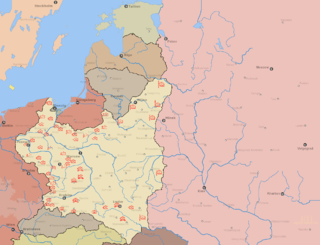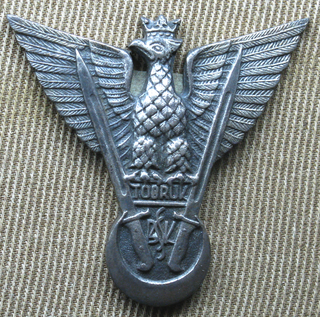Related Research Articles

Stanisław Franciszek Sosabowski was a Polish general in World War II. He fought in the Polish Campaign of 1939 and at the Battle of Arnhem (Netherlands), as a part of Operation Market Garden, in 1944 as commander of the Polish 1st Independent Parachute Brigade.

This article discusses the Polish order of battle during the invasion of Poland. In the late 1930s Polish headquarters prepared "Plan Zachód", a plan of mobilization of Polish Army in case of war with Germany. Earlier, the Poles did not regard the Germans as their main threat, priority was given to threat from the Soviets.

The Siege of Warsaw in 1939 was fought between the Polish Warsaw Army garrisoned and entrenched in Warsaw and the invading German Army.

This is the order of battle for the Guadalcanal Campaign, called Operation Watchtower, the first major Allied offensive in the Pacific Theater of Operations in World War II. The campaign lasted from the initial American landings on 7 August 1942 until the final Japanese evacuation on 9 February 1943, a period of six months, far longer than was expected by Allied planners.

Polish Independent Carpathian Brigade was a Polish military unit formed in 1940 in French Syria composed of Polish soldiers exiled after the invasion of Poland in 1939 as part of the Polish Army in France. It was commanded by General Stanisław Kopański.
The Battle of Mława, otherwise known as the Defence of the Mława position, took place to the north of the town of Mława in northern Poland between 1 and 3 September 1939. It was one of the opening battles of the Invasion of Poland and World War II in general. It was fought between the forces of the Polish Modlin Army under General Krukowicz-Przedrzymirski and the German 3rd Army under General Georg von Küchler.

The 28 Dywizja Piechoty was a Polish Army infantry division which saw action against the invading Germans during the Invasion of Poland of World War II. The division suffered heavy casualties in battles near Łódź and the remnants retreated to Warsaw, where they surrendered.

Polish 1st Legions Infantry Division is a tactical formation of the Polish Army. Formed on February 20, 1919, partially of veterans of the I Brigade of the Polish Legions, the unit saw extensive action during the Polish-Soviet War and World War II. Regarded by the soldiers of the Wehrmacht as the Iron Division, it distinguished itself in the Invasion of Poland.

The 36th Infantry Regiment of the Academic Legion was a Polish military unit. Initially made up of students from the University of Warsaw and the Warsaw University of Technology, it fought with distinction in the Polish-Bolshevik War, the Polish Defensive War and in the Warsaw Uprising.

Wincenty Kowalski (1892–1984) was a Polish military commander and a general of the Polish Army. A veteran of both World War I and World War II, he fought in all the inter-war conflicts of Poland. During the Invasion of Poland of 1939 he commanded the Polish 1st Legions Infantry Division.
The following is the order of battle of the forces involved in the Battle of Shanghai, during the opening stages of the Second Sino-Japanese War.
The Warsaw Army was one of the Polish armies to take part in the Polish Defensive War of 1939. Created on 8 September, eight days after the invasion begun, it was an improvised formation charged with the defence of the Polish capital of Warsaw (Warszawa).

The I Army Corps was a corps of the German army during World War II. It was active between 1934 and 1945, and participated in the Invasion of Poland, the Battle of France and the campaigns on the Eastern Front before eventually ending the war trapped in the Courland Pocket.
20th Infantry Division was an infantry division of the Polish Army during the interbellum period, which took part in the Polish September Campaign. It was formed in 1920 from the reorganization of the 2nd Lithuanian-Belarusian Division. Stationed in Baranavichy and commanded by Colonel Wilhelm Lawicz-Liszka.

Modlin Army was one of the Polish armies that were part of the Polish defense against the German Invasion of Poland. After heavy casualties in the battle of Mława, the Army was forced to abandon its positions near Warsaw around September 10; eventually it took part in the battle of Tomaszów Mazowiecki and surrendered afterwards.

The Battle of Radzymin took place during the Polish–Soviet War (1919–21). The battle occurred near the town of Radzymin, some 20 kilometres (12 mi) north-east of Warsaw, between August 13 and 16, 1920. Along with the Battle of Ossów and the Polish counteroffensive from the Wieprz River area, this engagement was a key part of what later became known as the Battle of Warsaw. It also proved to be one of the bloodiest and most intense battles of the Polish–Soviet War.

Battle of Łomża was a series of armed engagements during the Nazi German and Soviet Invasion of Poland. The battle took place in and around the town of Łomża, on both sides of the Narew River. Polish forces successfully held a series of pre-First World War forts from repeated German attack before being forced to withdraw due to the position becoming untenable following their losses at the Battle of Wizna and Battle of Nowogród.

13th Children of Kraków Infantry Regiment was an infantry regiment of the Polish Army. It existed from 1918 until 1939. It was then reformed two more times between 1941 and 1944 as part of the Polish Armed Forces in the East. Garrisoned first in Kraków, then in Krzemieniec and in 1921–1939 in Pułtusk, the unit belonged to the 8th Infantry Division from Modlin.
The Warsaw Military District was one of three military districts in Poland, the other two being the Pomeranian Military District and the Silesian Military District. It was the regional executive body of the Ministry of National Defense of Poland in the capital of Warsaw in operational and defense matters and military administration existing from 1945 to 1998.
References
- Edward Kospath-Pawłowski; Piotr Matusak; Dariusz Radziwiłłowicz (1995). 8 Dywizja Piechoty w dziejach Oręża Polskiego (in Polish). Pruszków: Ajaks. p. 235. ISBN 83-85621-71-7.